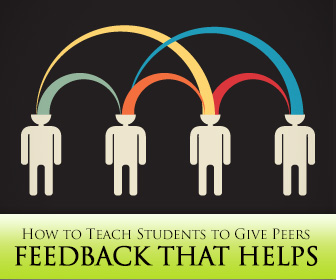Peer Review Renew: 5 New Ways to Approach Peer Feedback


Students took an inordinate time reading the papers. The comments were superficial: “Yeah, I liked it. It was good.” This was when they were actually focused on the papers and not talking off topic about weekend plans or their new holiday gifts. With some adjustments, however, I now love peer review.

A successful peer review session needs to be set up well in advance--the sessions that don’t go so well are often not well-planned. Students have a way of forgetting the session, not bringing their papers, not finishing them, not being in class at all, if they have not been prepared for the session. Sending out email alerts, putting the session on the course calendar, reminding students the session before, as well as awarding points that students will lose if they don’t attend or bring their papers, eliminates a lot of these issues.
Novice students by nature need to be oriented to an academic discussion. At least a session ahead I begin preparing students for the expectations of an peer review: to actively listen, taking notes as necessary, to your peers; to hear them out and not get defensive over one’s work (even though they may disagree with the advice and even ultimately reject it, as is their right as writers), and to respect their peers by focusing on their work and offering pertinent response beyond the superficial “I liked it.” A list of “rules of engagement” given out and discussed a session ahead can be helpful.
Again, inexperienced students need guidance in what they are expected to do in responding to each other’s work. An important point I emphasize is that students are responding as readers on how the piece worked for them as individual readers. They are not there to edit the piece but to respond on how the writing convinced them, informed them, moved them to action on the topic, etc., or failed to do so, and why. Students are not there to discuss comma placement, unless the comma placement was a major concern that impeded readability and comprehension.
This point on reviewer role leads to the second major pointer: focusing on global rather than minor concerns. It’s more important to note major concerns with development and research citation in a piece, for example, than the misspelling on page 2 because the lack of development is more striking and impedes comprehension more, and once the piece is revised, the sentence structure and punctuation may very well change in any case. Editing, of course, plays a role, but not in peer review for the final reason that while students are qualified to respond to a piece and how it resonated with them as readers, they usually do not have the expertise to offer editing advice, and that is best left for the instructor when she has a look at the papers. With that said, most students can point out a major problem with grammar/mechanics (“I’m not a teacher, but I think there’s a lot going on here with your spelling, and I’m having trouble understanding this sometimes.”) I find it helpful to give out another guidance sheet at the beginning of each peer review which students can refer to as they read (“Is the main idea clear?” “How would you rate the development?” and so forth.) Students rate each element, from the thesis statement down to the grammar and mechanics, on a 3 point scale of “strong” “fair” and “needs work.” They are only asked to fill out the form, which they give to their peer at the end and discuss. They are not required to mark up or edit their peers’ papers. Two final, global questions I ask students to particularly address at the end are “What is one thing you think really works in the paper?” and “What do you think needs additional work?” Again, students are asked to respond simply as readers of the essay, not as teachers or editors, as they might discuss strengths and weaknesses of a favorite novel. Once they have had some experience in the process, however, students are capable of offering extended and insightful comments.
Most instructors know this, but peer review is not break time. It is a time to walk around and facilitate discussion, which might mean going to the pair or group that seems to be “finished” and asking some probing questions: “What do you mean your partner’s work was ‘good’? In what way; how did it work for you; which parts were particularly good and why?” This gets students more engaged in the process and models how to extend a discussion beyond the superficial.
In wrapping up, have students reflect on the kinds of concerns seen in the papers and quality of feedback given. At the end of each peer review session, I bring the class together for a final reflection on the process by asking how it worked for them, if they now had more direction for revision. Because they have been offered an extended response by at least one reader, the answer is invariably “yes” and that they know what to do now. I then ask more specific questions about areas they saw as already strong and areas needing work with peers’ work. Often “development” is mentioned extensively: how much the writer engaged in the topic, giving explanation and examples, with students as a class either needing more work in this area or already mostly strong in it. Other issues are also frequently mentioned include the need more organization and transitions to help the reader follow the main points. This end discussion reinforces the advice already given in the peer review and pinpoints for the instructor areas the class as a whole needs to review in future class sessions.
Many classes, even onsite, face-to-face classes, now come equipped with a “Learning Management System” or website designed specifically for college classes which can be individualized for the specific class. An ideal use for this “course shell,” as it’s sometimes called, is the threaded discussion portion, where students can post to a topic and reply to each other on the topic. If students post their essays and then are asked to respond, at length--at least in a paragraph--to each other’s work, this is another opportunity for great exchange. This may even work better than a face-to-face exchange over each other’s work as there is more time to read, reflect on, and respond to the work. More introverted students in particular have been shown to do well in online discussions as the anxiety of having to respond on the spot is removed. Students often really get engaged in these online discussions--often more than they do in class--going beyond the requirement in responding with and replying to critique of various papers.
Does it have to be a painful and futile process? Again, no. With some ground rules and guidance, peer review day develops students’ reading skills, discussion, and critiquing skills, developing the class as both students and writers.
What Are Some of the Methods You Find Work for Peer Review?